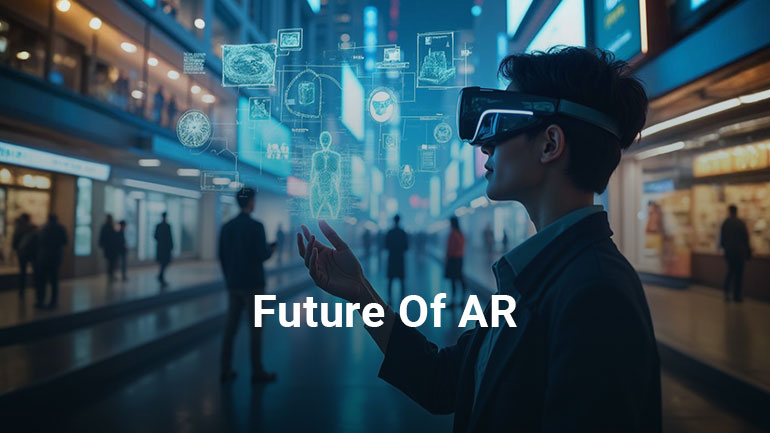
AR is revolutionizing gaming, retail, healthcare, and education, enhancing daily life and unlocking future possibilities beyond sci-fi dreams.
Augmented reality: what’s behind it?
Using augmented reality, digital content such as pictures, videos, and 3D models can be overlay on the physical world. Despite virtual reality (VR), which creates a fully realistic digital setting, augmented reality (AR) modifies the real world by including interactive features. The strength and adaptability of AR come from the addition of the real world.
AR’s Actual State
AR has already achieved great progress in a number of areas. AR has become popular via apps like Pokémon GO and Snapchat filters, and it’s utilized by businesses like retail and real estate to give customers real-time experiences. Before making a purchase, customers can see how the item of furniture appears in their homes by using brands like IKEA.AR is regularly employed in healthcare for medical education and operative planning, offering physicians to perform difficult surgeries in a risk-free setting. In the same way, AR is enhancing learning in the classroom by giving conceptual concepts life.
AR’s Future: What really to Expect
1. Systemic Acquisition in Routine
Opportunities for AR technology will extend beyond specific industries as it becomes broadly available. It seems likely that advanced glasses and other AR-enabled equipment will become more prevalent like smartphones, allowing AR to be simply integrated into our daily activities. Consider having access to real-time geographical signs or quick information about stores, restaurants, and landmarks while you are on the move.
2. Improving Shopping Experiences
AR has been used by retailers to close the distance between in-person and online shopping. AR could possibly enable virtual trials for apparel, accessories, and even cosmetics, helping buyers to make better choices. For e-commerce companies, this will lower return rates while also improving satisfaction among consumers.
3. Transforming Collaboration in the Workplace
AR has the power to change the way we operate. During meetings, remote teams might visualize and work with 3D models or data overlays using augmented reality (AR). AR-powered solutions that optimize design and production processes will be advantageous for sectors including engineering, manufacturing, and architecture.
4. Improvements in Medical Technology
There will be many more creative applications of AR in the healthcare industry. AR will increase accuracy and result in everything from letting patients see their treatment plans to providing surgeons with real-time data during procedures. Additionally, by developing immersive settings for exposure therapy or relaxing techniques, AR may be extremely important in mental health therapy.
5. Immersion Games and Entertainment
The gaming sector will keep pushing AR’s limits to produce more engaging and interactive experiences. Future augmented reality games may smoothly merge the real and virtual worlds, enticing users to discover new ways to interact with their environment. Beyond gaming, AR’s improved viewing experiences will transform live events, concerts, and sports.
6.Training and Education
Learning will become more individualized and participatory with AR. Through AR simulations, students could investigate scientific occurrences, historical events, or even space travel. AR will give professional training participants practical experience without the hazards of real-world practice, such operating heavy machinery or flying an airplane.
7. IoT and AI integration
New opportunities will arise as augmented reality (AR) converges with artificial intelligence (AI) and the internet of things (IoT). While IoT devices can contribute real-time data into AR applications, AI-powered AR systems can offer tailored recommendations. For example, AR might be used by smart houses to show security alarms or energy usage right in front of you.
Obstacles to Getting Past
Notwithstanding its potential, AR has a number of drawbacks. Data security, privacy issues, and the high price of AR gadgets are major obstacles to their broad use. Additionally, it takes a lot of resources and experience to produce high-quality AR material. But these problems should go away as technology develops and gets more accessible.
Conclusion
The area of AR has an exciting future. Our daily activities will be greatly transformed by digital reality as it develops further, transforming the way we work, learn, shop, and pass the time. Companies that adopt AR first will have a competitive advantage, and customers will have more engaging and customized experiences. The voyage is just getting started, and the possibilities are unlimited. Is the augmented future something you’re prepared to embrace?
